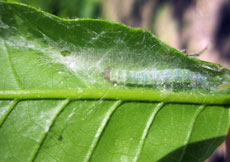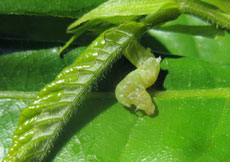Michigan chestnut update – June 6, 2013
Potato leafhoppers have arrived in Michigan and obliquebanded leafroller activity continues.
So far this season the East Lansing Enviro-weather station has accumulated 526 GDD50 with 0.27 inches of rain over the past week; the Clarksville Enviro-weather station has recorded 479 GDD50 with 0.31 inches of rain this past week; and the Northwest Michigan Horticultural Research Center accumulated 381 GDD50 with 0.67 inches of rain over the last week. Chestnuts in northern Michigan have catkins just beginning to emerge.
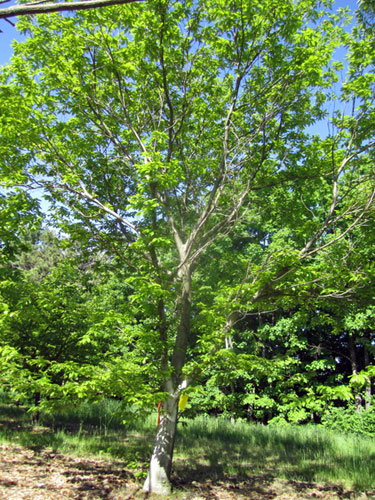
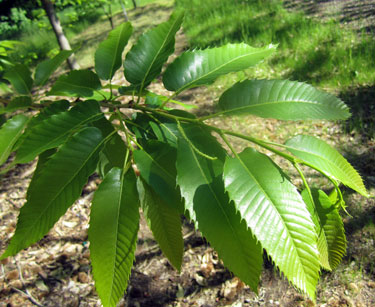
Development of the European/Japanese hybrid
Colossal in northwest Michigan on June 4, 2013.
Photo credit: Erin Lizotte, MSU Extension
No adult mites or eggs were visible during scouting in the northwest this week, but reports from Michigan State University Extension personnel in the Clarksville, Mich., region indicate that adult activity is underway for European red mite and eggs are visible.
Potato leafhoppers were caught in traps this week with one grower report coming in late last week. Growers should continue to monitor for potato leafhoppers to determine population level and treatment efficacy. Growers can hang yellow sticky traps in orchards to continue monitoring for this pest.
Like many plants, chestnuts are sensitive to the saliva of potato leafhoppers which is injected by the insect while feeding. Damage to leaf tissue can cause reduced photosynthesis that can impact production and quality, and damage the tree. Most injury occurs on new tissue on shoot terminals with potato leafhoppers feeding near the edges of the leaves using piercing-sucking mouthparts. Symptoms of feeding appear as whitish dots arranged in triangular shapes near the edges. Heavily damaged leaves are cupped with necrotic and chlorotic edges and eventually abscise from the tree. Severely infested shoots produce small, bunched leaves with reduced photosynthetic capacity.
Adult leafhoppers are pale to bright green and about 1/8 inch long. Adults are easily noticeable, jumping, flying or running when agitated. The nymphs (immature leafhoppers) are pale green and have no wings, but are very similar in form to the adults. Potato leafhoppers move in all directions when disturbed, unlike some leafhoppers that have a distinct pattern of movement.
The potato leafhopper can’t survive Michigan’s winter and survives in the Gulf States until adults migrate north in the spring on storm systems. Yellow sticky traps are recommended to determine when the first potato leafhoppers arrive. Growers should also walk through their orchards, flipping over leaves and looking for adult potato leafhoppers.
The most common classes of insecticides recommended for control of potato leafhoppers include the pyrethroids, carbamates, neonicotinoids and organophosphates. See the additional article, “Potato leafhopper management in chestnuts,” for more information.
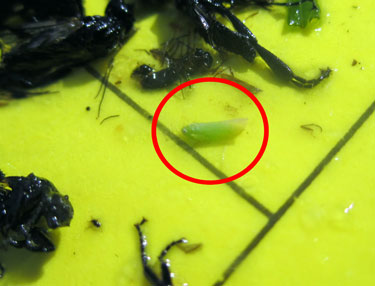
Potato leafhopper on yellow sticky trap.
Photo credit: Erin Lizotte, MSU Extension
Feeding damage from overwintering obliquebanded leafroller larvae continues on terminal foliage this week. Obliquebanded leafrollers are a common pest in apple and cherry orchards, but will feed on a wide range of plants. Some feeding damage to foliage can be tolerated in chestnuts, but larvae may also feed on bud tissue, so scouting for this pest is important.
Obliquebanded leafroller larvae roll leaves and create a tubular chamber where they remain except when feeding. Mature larvae are around 1 inch in length, have a flattened, black head capsule and yellowish-green bodies. Overwintering larvae that we are observing now often feed inside bud clusters; newly hatched larvae from the summer generation feed on leaves. The larvae currently present will pupate into the adult moths over the coming weeks. Adults emerge and mate, laying eggs for a second generation of larvae that typically peaks in July.
Pyrethroids and spinosyn-based insecticides are the standard classes used to target the larval phase of this insect (refer to the chestnut pesticides table for more information on labeled products). Growers should not spray for obliquebanded leafrollers unless they have confirmed the presence of this pest at a damaging level.
To scout for obliquebanded leafrollers, walk through the orchard looking for distorted terminals with leaves that appear to not have expanded properly. Unroll the leaves to look for larvae. Growers may also purchase pheromone lures for use in delta traps to capture adults. Trapping adults is a good indication of presence and potentially gives a sense of population levels, but because this insect overwinters as larvae, adults will be captured only after the initial damage from overwintering larvae is done, making the visual scouting important. Additionally, growers only trapping adults will miss the first larval treatment window, which may be important if high populations occur.
It was also great to observe small, jumping spiders feeding on leafrollers at more than one location this week.



 Print
Print Email
Email
